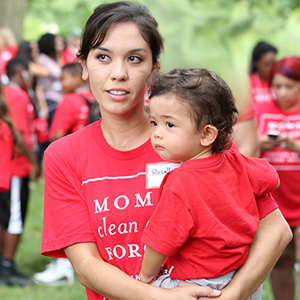
Learn more about asthma
Asthma is a chronic lung condition in which the airways become inflamed, making it harder to breathe. Asthma can cause wheezing, breathlessness, coughing, chest tightness, disturbed sleep, school absences, curtailed physical activity, hospital visits, and, in rare cases, death.
More than 8% of all US children have asthma. It is the most common chronic disease of childhood.
There is growing evidence that the onset of childhood asthma can be triggered by air pollution.
What is asthma?
Asthma is a chronic lung disease that causes repeated episodes of wheezing, breathlessness, chest tightness, and nighttime or early morning coughing. If you have asthma, you have it all the time, but you will have asthma attacks only when something bothers your lungs.
Asthma most often starts in childhood. It is one of the most common long-term diseases of children, but many adults have asthma as well. In the United States, more than 26 million people are known to have asthma. Nearly 7 million of these people are children; children under four are increasingly affected, as this age group had the highest rate of hospitalization for asthma.
Asthma is the most common chronic disease in childhood—and its incidence is increasing. In 1980, 3.6% of U.S. children had it; in 2001, 9% – a 250% increase. It is the third-leading cause of hospitalizations among children under the age of 15.
There is no cure for asthma. The best way to manage asthma is to know your triggers and the warning signs of an attack, as well as following the advice of your doctor. Although asthma cannot be cured, it can be effectively controlled. If you are aware of triggers and the warning signs of an attack, and follow your doctor’s advice, your asthmatic child can lead a relatively normal life. When asthma is well controlled, your child can avoid symptoms such as wheezing or coughing; disturbed sleep; school absences; curtailed physical activity; and hospital visits.
What is an asthma attack?
As an asthma sufferer, your airways will always have some irritation, though when you have an asthma attack, this irritation gets worse. Asthma attacks, also called episodes, can be recognized by the occurrence of coughing, chest tightness, wheezing, and having trouble breathing.
The attack happens in your body’s airways—the paths that carry air to your lungs. As the air moves through your lungs, the airways become smaller. During an asthma attack, the sides of the airways in your lungs swell and the airways shrink. Less air gets in and out of your lungs, and mucus that your body produces clogs up the airways even more.
What causes asthma?
Asthma is a disease of genetics and the environment. If someone in your family has asthma, you are more likely to have it. Yet there are environmental factors that influence whether people develop the disease. For example, people living in rural areas have lower rates of asthma compared to city-dwellers. (Some researchers think that this is due to the lack of microorganisms in modern, urban environments.)
While the development of asthma seems to have a genetic component, outside factors are what set off, or trigger, asthma attacks in people who have the disease.
An asthma attack can occur when someone with asthma is exposed to things in the environment, such as diesel exhaust, smog, house dust mites, and tobacco smoke. These are called asthma triggers. Asthma triggers cause symptoms in people who already have the underlying disease. One person’s triggers can be very different from those of another person with asthma. It is important to be aware of what your, or your child’s, triggers are. Click here for a list of important asthma triggers. More important information on asthma triggers from the American Lung Association.
What can I do to reduce asthma triggers?
Here are some tips from the EPA:
Outdoor Air Pollution
- Monitor the Air Quality Index on your local weather report.
- Know when and where air pollution may be bad.
- Regular exercise is healthy. Check your local air quality to know when to play and when to take it a little easier.
- Schedule outdoor activities at times when the air quality is better. In the summer, this may be in the morning.
- Stay inside with the windows closed on high pollen days and when pollutants are high.
- Pay attention to asthma warning signs. If you start to see signs, limit outdoor activity. Be sure to talk about this with your child’s doctor.
In addition, you can reduce your household’s electricity and gasoline consumption. Your fossil fuel consumption directly impacts air pollution levels and contributes to asthma triggers.
- Turn up your thermostat and use fans in the summer to reduce electricity consumption of your air conditioner
- Turn down your thermostat in the winter
- Dry your laundry on a line or a rack instead of using electricity to dry it in the dryer
- Replace incandescent light bulbs with compact fluorescent or LED bulbs
- Bike, bus, and carpool to reduce driving time and get more exercise
- Replace your old wood-burning stove with a cleaner, modern one
- When buying a car, search for fuel-efficient models
- When buying appliances, search for energy-efficient models
Secondhand Smoke (from the EPA)
- Don’t let anyone smoke near your child.
- If you smoke: until you can quit, don’t smoke in your home or car.
Dust Mites (from the EPA)
- Wash bedding in hot water once a week. Dry completely.
- Use dust proof covers on pillows and mattresses.
- Vacuum carpets and furniture every week.
- Choose stuffed toys that you can wash. Wash stuffed toys in hot water. Dry completely before your child plays with the toy.
- Dust often with a damp cloth.
- Vacuum carpet and fabric-covered furniture to reduce dust build-up using a high efficiency (HEPA) filter. People with asthma or allergies should leave the area being vacuumed.
Molds (from the EPA)
- If mold is a problem in your home, you need to clean up the mold and eliminate sources of moisture.
- If you see mold on hard surfaces, clean it up with soap and water. Let the area dry completely.
- Use exhaust fans or open a window in the bathroom and kitchen when showering, cooking or washing dishes.
- Fix water leaks as soon as possible to keep mold from growing.
- Dry damp or wet things completely within one to two days to keep mold from growing.
- Maintain low indoor humidity, ideally between 30-50% relative humidity. Humidity levels can be measured by hygrometers, which are available at local hardware stores.
Cockroaches and Pests (from the EPA)
- Keep counters, sinks, tables and floors clean and free of clutter.
- Clean dishes, crumbs and spills right away.
- Store food in airtight containers.
- Seal cracks or openings around or inside cabinets.
- Household pesticides can trigger asthma attacks. Use physical barriers and prevention, not chemicals, as your first line of defense against pests.
Nitrogen Dioxide (from the EPA)
- Gas cooking stoves: If you have an exhaust fan in the kitchen, use it when you cook. Never use the stove to keep you warm or heat your house.
- Unvented kerosene or gas space heaters: Use the proper fuel and keep the heater adjusted the right way. Open a window slightly or use an exhaust fan when you are using the heater.
Chemical Irritants (from the EPA)
- Make sure your child is not around when using chemical irritants, such as solvents, in the home.
- Open windows or doors, or use an exhaust fan.
- Always follow the instructions on the product label.
- Look for low-VOC products, or make your own non-toxic household cleaners from common kitchen ingredients.
Wood Smoke (from the EPA)
- To help reduce smoke, make sure to burn dry wood that has been split, stacked, covered, and stored for at least 6 months.
- Have your stove and chimney inspected every year by a certified professional to make sure there are no gaps, cracks, unwanted drafts or to remove dangerous creosote
build-up. - If possible, replace your old wood stove with a new, cleaner heating appliance. Newer wood stoves are at least 50% more efficient and pollute 70% less than older models. This can help make your home healthier and safer and help cut fuel costs.
What's the difference between causing asthma and triggering asthma?
A cause is an underlying reason why a person gets asthma or other disease. The exact causes of asthma are unknown, but experts have shown that exposure to cigarette smoke, air pollution, and allergens can increase asthma prevalence in populations. A trigger is something that causes an asthma attack in someone already suffering from the disease. There are many known triggers of asthma attacks, including diesel exhaust, smog, particle pollution, cigarette smoke, perfume, pet dander, and allergens from dust mites and cockroaches. Several air pollutants, including diesel exhaust and ground-level ozone, may both cause the development of asthma and trigger asthma attacks.
Click here for a more in-depth look on the connection between air pollution and asthma causation.
Is asthma worse at night?
According to the American Lung Association, there is such thing as nocturnal asthma. Nocturnal asthma refers to asthma symptoms that seem worse in the middle of the night, typically between 2AM and 4AM. Nocturnal asthma can affect someone with any type of asthma.
Factors that can cause your asthma symptoms to worsen at night may include sinus infections or postnasal drip caused by allergens such as dust mites or pet dander. Your body clock may also play some role. The body makes adrenaline and corticosteroids, which protect against asthma. Levels of these two substances are lowest between midnight and 4AM, making it more likely you will experience symptoms during these times.
Is there a connection between asthma and allergies?
Yes. In fact, allergic asthma is a type of asthma that is triggered by allergens—such as dust mites, pollen and mold. According to the American Academy of Allergy, Asthma and Immunology, half of the 20 million Americans with asthma have allergic asthma, and about 70% of asthmatics also have allergies.
How does turning on the lights relate to asthma?
While you may not think about it, every time you turn on the lights you may be causing asthma triggers to be emitted into the air.
Unless your electricity is generated by renewable energy sources, your lights are most likely powered from the combustion of fossil fuels, which contribute to unhealthy air quality—which can worsen and aggravate asthma.
Your utility may now offer the option to choose greener, more environmentally friendly sources of energy—click here for more information from the EPA.
[toggle title=”How does air pollution affect asthma?”] Several components of outdoor air pollution trigger asthma attacks: fine particles (soot), ground level ozone (smog), diesel exhaust, sulfur dioxide, nitrogen dioxide, and carbon monoxide. The major sources of these pollutants are power plants, cars, trucks, buses, and industrial processes and machinery.
Research shows that air pollution triggers asthma at levels commonly present in the US. For example, a 2-year study supported by the National Institutes of Health NIH and the EPA showed that even modestly increased levels of air pollution cause more frequent asthma symptoms and lower lung function in children who have persistent asthma and live in inner city areas of the United States. Even air pollution levels within EPA’s safety standards made asthma worse in vulnerable children.
According to the study, high levels of nitrogen dioxide, a component of motor vehicle emissions, had the greatest effect, leading to many asthma-related school absences.
Ozone and particle pollution can also trigger asthma attacks and worsen lung function.
Additional asthma triggers include nitrogen oxides, formaldehyde, and tobacco smoke, and biological agents such as respiratory infections and allergens. Other toxic air contaminants like pesticides are suspected of contributing to asthma attacks but have not been conclusively proven to do so.
Nearly two-thirds of those suffering from asthma live in an area where at least one federal air-quality standard is not being met.
It is important to pay attention to air quality forecasts in your region, and plan your outdoor activities during times of low air pollution levels. Click here to learn about air quality in your area.
What's the controversy around inhalers?
Prior to 2009, albuterol metered dose inhalers (MDIs), also called “short-acting” or “rescue” inhalers, traditionally used chlorofluorocarbons (CFCs) to “propel” the albuterol into the lungs. CFCs are dangerous, as, when emitted, they travel to the stratosphere and are broken down by strong ultraviolet (UV) light, where they release chlorine atoms that then deplete the ozone layer.
In accordance with the Montreal Protocol on Substances that Deplete the Ozone Layer, which was signed by the United States in 1987, the United States has been committed to phasing out, and ultimately eliminating, substances that deplete the ozone layer—which includes MDIs using CFC as a propellant.
A new safe and effective alternative propellant, hydroflouroalkane (HFA), was created to replace CFCs. This propellant has become the required standard for all inhalers.
In a 2010 news release, the FDA announced a phase-out plan for 7 inhalers that use CFCs.
Click here for more information from the EPA on the transition.
Companies that produce inhalers that use CFC propellants are not happy with the phase-out, which was made clear in a July 2012 proposed bill called The Asthma Inhalers Relief Act. This bill would enable inhalers that contain harmful CFCs to be put back on the shelves. One company in particular, Amphastar Pharaceuticals, is lobbying hard for the bill, as they misjudged demand and have found themselves with an abundance of inhalers that are currently unsellable.
Is asthma worse during certain seasons?
As Moms Clean Air Force blogger Gina Carroll explains, fall and winter are allergy and asthma high-alert, high-incidence periods. In fact, the steep increase in fall asthma emergencies is so prevalent; it has been referred to as the “September epidemic” in a 2004 study published in the Journal of Allergy and Clinical Immunology. Therefore, it is important to be extra careful about day-to-day asthma maintenance.
The hot summer months are tough on asthma patients as well. Ozone levels increase during the summer, for ozone is exacerbated by sunlight and hot weather–leading to unhealthy concentrations of ozone in the air. People with asthma are known to be especially susceptible to the effects of ozone exposure.
How does asthma affect school attendance?
Among children ages 5 to 17, asthma is the leading cause of school absences due to a chronic illness. It accounts for an annual loss of more than 14 million school days per year (approximately 8 days for each student with asthma).
Click here for resources from the American Lung Association on how you can work with your child’s school to ensure that your child’s asthma is best managed and that they stay safe and healthy.
What about asthma and African Americans?
When it comes to asthma, communities of color are particularly hard-hit. In 2008, asthma prevalence was 35% higher in African Americans than in whites. A 2003 study revealed that one-quarter of the children in New York City’s Harlem have asthma. The following national statistics show that asthma disparities in African Americans are severe and widespread.
African American children have a:
• 260% higher emergency room visit rate;
• 250% higher hospitalization rate; and a
• 500% higher death rate from asthma, as compared with White children.
African Americans may suffer from asthma at a greater rate in part because they live closer to sources of air pollution than Whites. 68% of African-Americans (compared to 56% of Whites) live within 30 miles of a coal-fired power plant—the distance within which the maximum ill effects of the emissions from smokestacks occur.
What about asthma and breastfeeding?
Some research suggests that breastfeeding may prevent the development of asthma.
According to a 2010 study, feeding a baby on only breast milk and for up to 6 months after birth can reduce their risk of developing asthma-related symptoms in early childhood.
A similar 2007 study found that the lowest prevalence of asthma was found in children who were breastfed from four to six months.
A 2011 study concluded that breastfeeding, particularly exclusive breastfeeding, protects against current asthma up to 6 years. Although exclusive breastfeeding reduced risk of current asthma in all children to age 6, the degree of protection beyond 3 years was more pronounced in children with genetic predispositions to asthma.
However, the American Academy of Pediatrics thinks the evidence that breastfeeding protects against asthma is not convincing. In a 2008 review of the topic, they write: “At the present time, it is not possible to conclude that exclusive breastfeeding protects young infants… from developing asthma in the long term (>6 years of age), and it may even have a detrimental effect. On the other hand, breastfeeding seems to decrease the wheezing episodes seen in younger children (<4 years of age) that are often associated with respiratory infections.”
What are some tips on managing my child’s asthma?
It is important to be aware of your child’s asthma triggers, and to minimize exposure to these triggers. Since asthma triggers are not always completely within your control, it is also important to be especially diligent about sticking to prescribed medication regimens, as advised by your doctor. If you don’t already have an asthma action plan in place, use this helpful asthma action plan sheet from Kids Health. Your child’s doctor can advise you when filling out the form.
Germ control is important as well. Ensure everyone in the household gets flu shots, and be mindful of environmental irritants such cleansers, pesticides, and other household products.
It is also important to pay attention to air quality forecasts in your region, and plan your outdoor activities during times of low air pollution levels. Click here to learn about air quality in your area.
What about school buses and asthma?
Idling buses can increase local air pollution and trigger asthma attacks. Unfortunately, one of the most common places to find excessive idling is at school, where buses and parents wait to pick up students.
Old diesel buses are a significant source of particle pollution; the EPA and the American Lung Association rank diesel exhaust among the air pollutants that pose the greatest public health risk. Diesel exhaust from idling school buses can accumulate on and around the bus and pose a health risk, particularly to the 24 million children that ride a bus to and from school every day. Additionally, emissions from idling buses can also pollute the air inside school, posing a health risk to children throughout the day. Exposure to diesel exhaust can cause lung damage, as well as exacerbating asthma and existing allergies. Diesel exhaust is also a carcinogen.
Dr. Megan Sandel explains, “I had a child for whom diesel emissions from the buses [parked outside school] was a significant exposure. To walk in and out of school, the kids had to walk through the smog of idling. The school worked with local advocacy groups to move the buses and limit idling, and the child got better.”
It is important to make sure your school system is retrofitting old buses and has a strong anti-idling policy.
Click here for more information on starting an anti-idling campaign in your community.
Click here for more from the EPA on asthma and schools.
How many people die from asthma?
More than 4,000 people lose their lives each year from this disease. Among children, deaths due to asthma are tragic but rare. In 2007, 152 children under 15 died from asthma. African-American children are five times more likely to die of asthma than Caucasians. The number of deaths due to the disease increases with age.
According to the Centers for Disease Control and Prevention, 11 Americans die from asthma every day. Additionally, asthma is indicated as a “contributing factor” for nearly 7,000 other deaths each year.
According to findings from the CDC’s National Center for Health Statistics, more women than men die of asthma; overall, women account for nearly 65% of asthma deaths.
What are the costs of asthma?
Asthma care has a large impact on our health care system and our economy. The annual direct cost of asthma in the US is approximately $11.5 billion. The indirect costs (such as productivity) add another $4.6 billion, totaling $16.1 billion per year. Prescription drugs represent the single largest indirect cost at $5 billion.
Every year, asthma is responsible for 9 million visits to health care professionals. In 2000, more than 1.8 million emergency room visits (including 728,000 visits for children under 17) and more than 460,000 hospitalizations were attributed to asthma attacks.
Asthma is one of the leading causes of school absenteeism, accounting for over 14 million missed school days annually.
The economic burden of asthma has been estimated at $14 billion in 2002. Families with an asthmatic member suffer a severe emotional toll, through lost sleep, disrupted routines and restricted activities. Many families may also suffer undue financial burden with high medical bills.
According to the Center for Disease Control, the cost of treating asthma in children 18 and under alone is $3.2 billion per year. For adults, asthma is the fourth leading cause of work absenteeism and “presenteeism,” (attending work while sick), resulting in nearly 15 million missed or lost workdays each year, leading to a total cost of nearly $3 billion in total lost productivity.
What if I can’t afford prescription asthma medications?
Part of properly controlling asthma is using appropriate medication. Unfortunately, asthma medications can often come at a steep price.
Here are some resources that may be helpful when it comes to paying for these prescriptions:
- Partnership for Prescription Assistance can help those without prescription drug coverage who qualify, get the medicines they need for free or nearly free. They offer a single point of access to more than 475 public and private programs, including nearly 200 offered by pharmaceutical companies.
- RxAssist offers a comprehensive database of patient assistance programs
- Bridges to Access and GSK access are GlaxoSmithKline’s patient assistance programs. This is an important resource for asthma patients needing the pricey Advair, manufactured by GlaxoSmithKline. (GSK access is for Medicare patients)
- Healthwell Foundation is a non-profit organization established to assist individuals with insurance who cannot afford their co-payments, coinsurance, and premiums for important medical treatments.
- Genentech’s Xolair Assistance Programs is for folks who are prescribed the expensive medication, XOLAIR. The manufacturer has several programs to help the uninsured (XOLAIR Access Solutions and Genentech Access to Care Foundation) and those who need help with co-pays (XOLAIR Debit Card Program).
- If you find you can no longer afford medications for yourself or your child, BEFORE you stop taking your meds, ask your doctor or a hospital social worker for options. Hospital social workers are equipped to help you find grants and other resources to cost-free or reduced medicines.
References
http://www.cdc.gov/asthma/faqs.htm
http://www.cdc.gov/asthma/triggers.html
http://www.edf.org/health/air/asthma
http://newsinhealth.nih.gov/2008/May/docs/01features_02.htm
http://www.momscleanairforce.org/NDCBI.pdf
http://www.aaaai.org/about-the-aaaai/newsroom/asthma-statistics.aspx
http://www.lung.org/associations/states/colorado/asthma/Asthma.html
Disclaimer: this is meant to be used as a reference only, not a medical guide. Please consult your physician for any serious medical questions.




